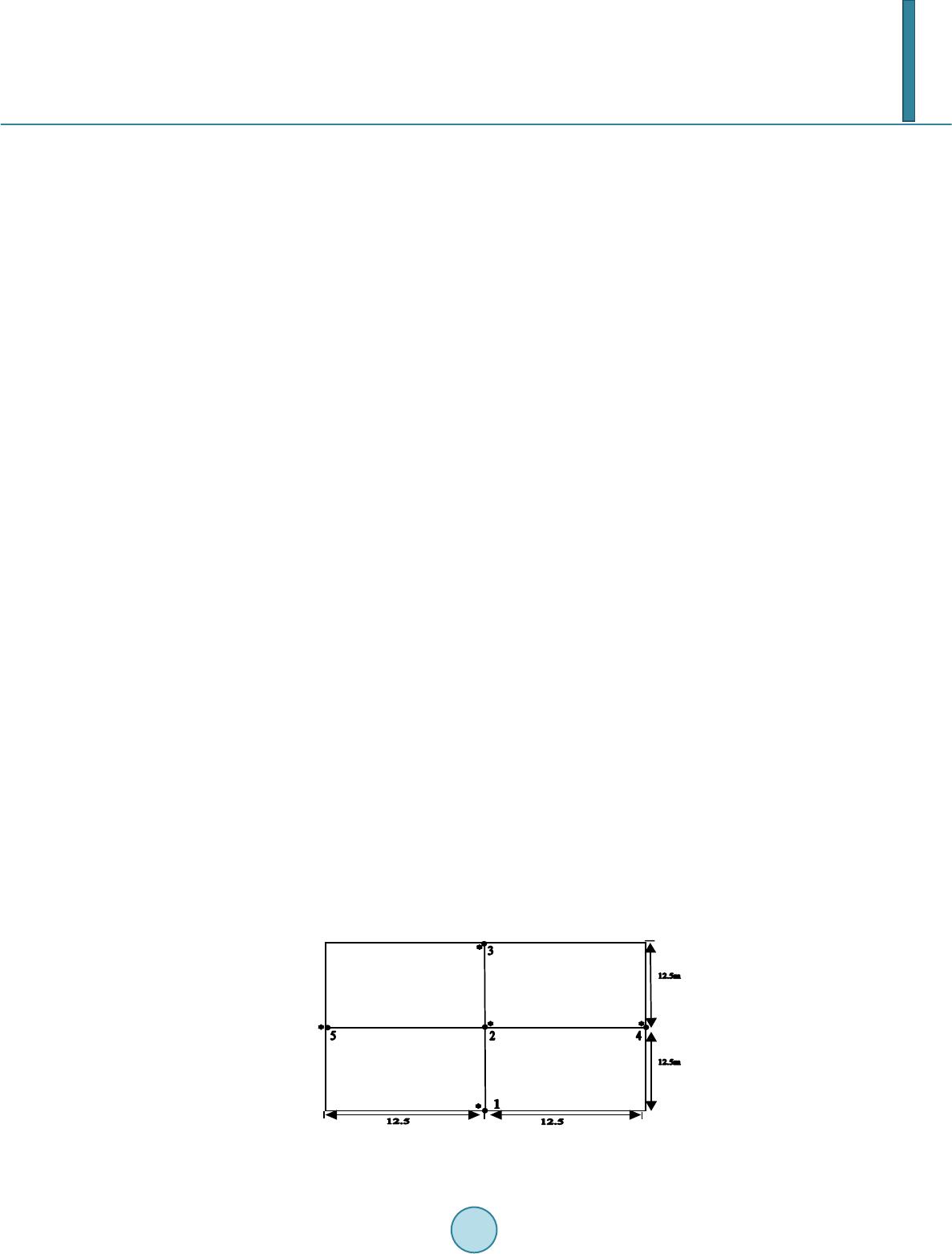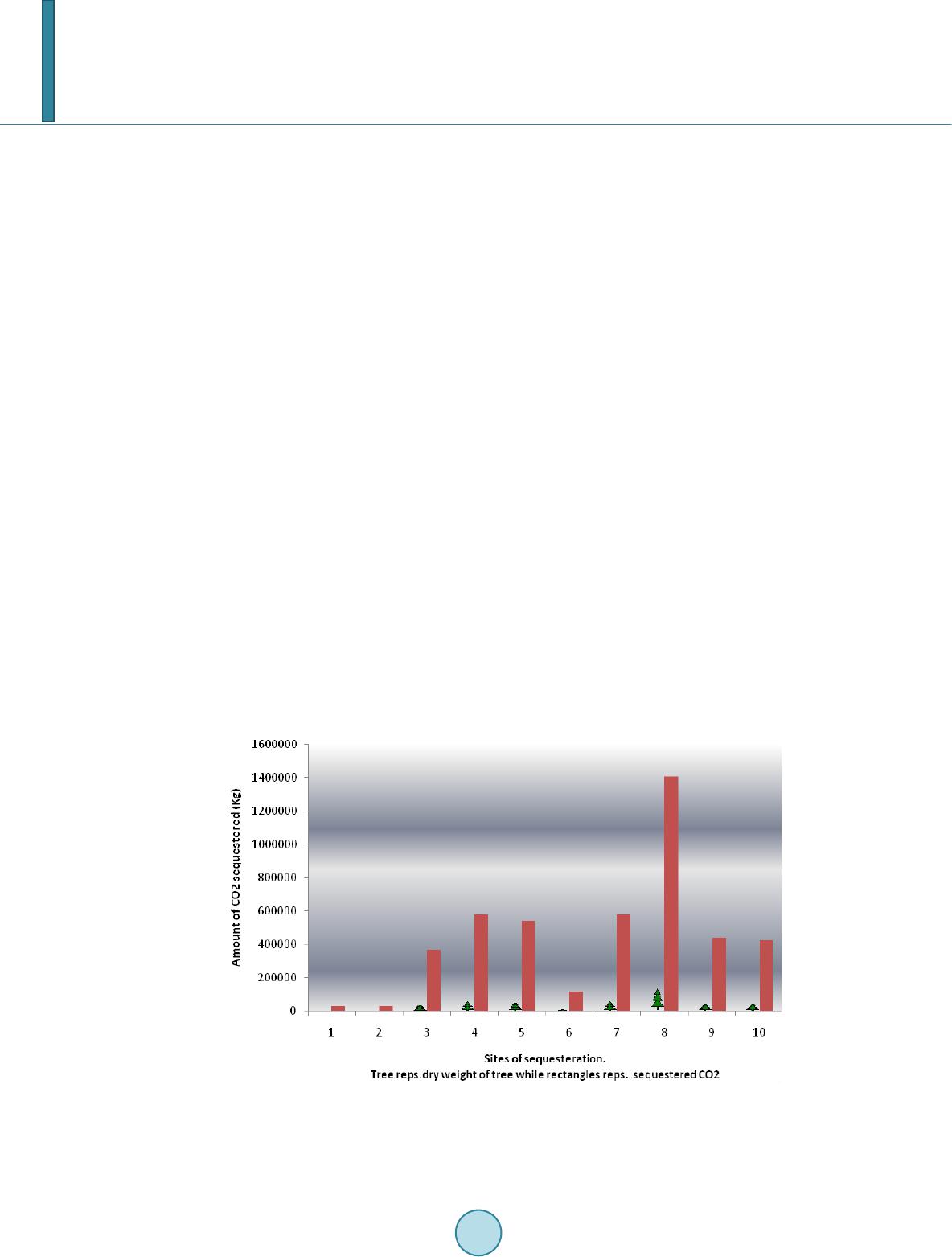 Journal of Geoscience and Environment Protection, 2014, 2, 157-166 Published Online April 2014 in SciRes. http://www.scirp.org/journal/gep http://dx.doi.org/10.4236/gep.2014.22022 How to cite this paper: Eneji, I. S. et al. (2014). Sequestration and Carbon Storage Potential of Tropical Forest Reserve and Tree Species Located Within Benue State of Nigeria. Journal of Geoscience and Environment Protection, 2, 157-166. http://dx.doi.org/10.4236/gep.2014.22022 Sequestration and Carbon Storage Potential of Tropical Forest Reserve and Tree Species Located within Benue State of Nigeria Ishaq S. Eneji1*, Ofoegbu Obinna1, Emmanuel T. Azua2 1Department of Chemistry College of Science, Federal University of Agriculture, Makurdi, Benue State, Nigeria 2Department of Biological Sciences, College of Science, Federal University of Agriculture, Makurdi, Benue State, Nigeria Email: *eneji3@yahoo.com Received Dec emb er 2013 Abstract Carbon sequestration potential of tree species within forest reserves and other sites in Makurdi Benue state of Nigeria was investigated using non-destructive Walkley-Black technique. The result indicates that P. americana has the highest CO2 seq uestr ation potential (125,916.7 kg), while T. grandis (10.4 kg) and D. regia (26.1 kg) were the least. The study also shows that trees (T. gran dis , S. actinophylla and P. ameri can a) with thick vegetation, broad and clustered leaves were found to be better CO2 sequesters. The relationship between the tree height and amount of CO2 sequestered gave a regression equation of y = 67898x + 9509 with R2 = 0.266, indicating insignificant varia- tions existing between tree height and CO2 sequestration at P > 0.05. Variations however existed between tree dominance and CO2 sequestration among trees investigated. This finding strategi- cally positions Benue tropical forest in line for carbon credit financing while substantiating the importance of preserving our indigenous forest and tree species. Keywords Benue; Carbon Credit; Tropical Forest; B io-Diversity; Sequestration Potential; B io-Sink 1. Introduction The importance of forests in extenuating climate change has led many countries to study the carbon budgets and carbon sequestration of their forests resource. The total global potential for afforestation and reforestation activi- ties for the period 1995-2050 is estimated to be an average of 1.35Pg C per year, of which 70% possibly will occur in the tropics (IPCC, 2001). Nigeria had sixty (60) million hectares of forest as area as at 1897 and it is established that this has declined during the 1990s at an estimated annual rate of 2.6% or more (≤398,000 hectares/year) (Oguntala, 1995; FAO, 2005). Observed causative agents were, agricultural expansion, encroachment, over-harvesting, bush burning, illegal harvesting and de-reservations. The Federal Department of Forestry postulated that the annual diminution  I. S. Eneji et al. rate may be as high as 3.5%, noting that the forest estate of Nigeria is being highly depleted with the Sahara Desert encroaching southward at a rate of about one kilometer per year. This phenomenon appearing very docile poses great natural risk and creates a disaster laden picture for the country, this makes mitigation and related containment activities very imperative. Plants’ propagative and vegetative mechanisms are known to contribute to the control of the experienced and increasing carbon dioxide emission in the environment. The utilization of available atmospheric CO2 in photo- synthetic process provides a natural sink for the excess carbon dioxide generated by anthropogenic activities. It is known that global emission of carbon dioxide has increased by 18% reaching its first peak level after 1750. An up surge level increase per year of 1.5 ppb in 1990-2000, 2 ppb in 2001-2009 and 2.3 ppb in 2009-2010 the highest in recent decades (Chavan and Rasal, 2012). Food and Agricultural Organization (FAO) report estimates that in Africa, deforestation accounts for nearly 70% of total emissions (FAO, 2005). Clearing tropical forests also destroy globally important carbon sinks that are currently sequestering CO2 from the atmosphere which are critical to future climate stabil ization (Stephens et al., 2007). Effective sequestration which is the net exclusion of carbon dioxide from the atmosphere and entrapment within long termed natural sinks is achieved by the presence and activities of plant species with life spans of not less than ten (10) years (SSSA, 2001). With this, estimates of carbon stocks and stock changes in tree biomass are necessary. Nigeria lack articulated data generation and banking in this area, hence stands to lose her natural carbon sinks. Above-ground biomass, below-ground biomass, dead wood, litter, and soil organic matter are the major carbon pools in any flora and fauna (Chavan and Rasal, 2012). Soil organic carbon is a large and active pool, containing roughly twice as much carbon as the atmosphere and 2.5 times as much as the biota and the amount of carbon sequestered at a site reflects the long-term balance between influx and efflux of carbon (SSSA, 2001). Benue state (7˚43'50"N 8˚32'10"E) has fourteen (14) forest reserves as part of her vegetative endowment. The primary and destructive activity going on at these sites is wood cutting/lumber business and this activity has be- come a threat to the existing biodiversity of the communities around the studied area. The culture of replanting is next to non-existent and with the establishment of industries as well as the existence of green house gas (GHG) generating activities; there is imminent risk exposure to the environment. Guesstimates of carbon stocks and stock changes in tree biomass are essential for keying into the United Na- tions Framework Convention on Climate Change (UNFCCC) programme and as required by Kyoto Protocol as well as for carbon credit trading. This research is the first phase of assessment of carbon sequestration potential of tree species found within forest reserves and sites in Benue State. 2. Methodology Sampling: Ten (10) sampling locations were identified and used in this investigation from two local govern- ment area namely: Gwer west and Makurdi. In Gwer west, Nagi was chosen as the sampling location due to its forest reserve with rural low emission area. Similarly, in Makurdi, Agan and Makurdi metropolis were chosen as sampling location with mild to heavy traffic emission areas. A total of four thousand two hundred (4200) trees belonging to twenty (20) different tree species were involved: Gmelina arborea, Tectona grandis, Anacardium occidentale L., Sarcocephalus latifolius, Anogeisus leiocarpa, Khaya senegalensis, Maranthes polyandra, Stry- chnos spinosa and Detarium microcarpum. Others are: Parkia biglobosa, Eucalyptus globules, Albizia lebbeck, Delonix regia, Schefflera actinophylla, Azadirachta Indica, Mangifera indica, Polyalthia longifolia, Ficus ben- jamina, Persea americana and Elaeis guineensis. Analytical Method: Using non-destructive method, the mean above and below ground organic carbon (tones/tree) and total organic carbon of each species of tree was calculated. Carbon enters the soil as roots, litter, harvest residues, and animal manure. Carbon is stored primarily as soil organic matter (SOM) and this was de- termined by the Walkley-Black procedure (SSSA, 2001) and the carbon stock was calculated with the formula = C (%)/100 × soil bulk density × area (1 ha) × soil depth (Figure 1). 2.1. Diameter at Breast Height (DBH) and Tree Height (TH) DBH was calculated by measuring the tree Trunk Circumference at 1.3 m from the ground for each tree with circumferences greater than 10 cm while direct measurement neglecting height from ground was done for trees with circumference less or equal to 10 cm (Figure 2). TH was obtained by direct measuring with surveyors’ tape by climbing, aided by a pole and confirmation us-  I. S. Eneji et al. ing calculation with Thiodolite angle and sides calculation (Figure 3). The angle between the tree top and eye view at breast height angle (α) is taken into consideration for tree height measurement and height of the tree is calculated. Considering the angle ACB between tree top and the distance (b) at the point of observer at DBH, the tree height was calculated if α is the angle between eye view and top of the tree, a is the height of the tree in feet, c is the slope between tree and eye view, b is the distance in feet between tree and observer and h is height of horizontal plane of Thiodolite instrument, then the height of tree (H) is calculated by the following formulae: H = h + b tan α 2.2. Determination of Biomass and Carbon Dioxide Sequestered by Tree We adopted the method recommended by Chavan and Rasal (2010) with slight modification into five stages as follows: 1) Total (green) weight of tree based on tree species for tropical forest species, the weight of a tree is: W = Above-ground weight of the tree in kilogram (kg); D = Diameter of the trunk in inches; H = Height of tree in Meters. Hence, for trees with D ≤ 10: W = 0.25D2H or trees with D ≥ 11: W = 0.15D2H. The root system weighs about 20% as much as the above-ground weight of the tree. Therefore, to determine the total green weight of the tree, multiply the above-ground weight of the tree by 120%. 2) Dry weight of tree based on an extension publication from the University of Nebraska (Chavan and Rasal, 2010). The dry weight of the tree was calculated by multiplying the weight of the tree by 72.5%. 3) Weight of carbon, The average carbon content is generally 50% of the tree’s total volume (DeWald et al., 2005). Therefore, the weight of carbon in the tree was calculated by multiplying the dry weight of the tree by 50%. 4) Weight of carbon dioxide sequestered (CO2 is composed of one molecule of Carbon and 2 molecules of Oxygen and The atomic weight of Carbon is 12.001115; The atomic weight of Oxygen is 15.9994). Hence, weight of CO2 is C + (2 X O) = 43.999915, while the ratio of CO2 to C is 43.999915/12.001115 = 3.6663. Therefore, to determine the weight of carbon dioxide sequestered in the tree, we multiplied the Weight of carbon in the tree by 3.6663 (Birdsey, 1992). 5) Weight of CO2sequestered in the tree per year was calculated by dividing the weight of carbon dioxide se- questered in the tree by the age of the tree. Statistical analysis was carried out using Genstat sp 18 package. The procedures used include summary statis- tics and linear regression. 3. Results and Discussion Assessment of carbon sequestration and storage potential of 4200 trees belonging to twenty (20) tropical tree species found within a local forest reserve and other sites in Makurdi Benue State of Nigeria was investigated. Carbon storage and sequestration potential of trees within Benue is presented from a rural traffic low emission area (Table 1), a mild to heavy traffic area (Table 2) and a heavy traffic high emission township (Tables 3-10), respectively. The relationship between dry weight of the studied trees and total sequestered CO2 is shown in Figure 4, while the relationship between heights of the studied trees to the total amount of CO2 sequestered (Figure 5), interprets the findings. Figure 1. Soil sample collection method, * = Sampling point.  I. S. Eneji et al. Figure 2. Diagrammatic representation of tree measure- ment methodology (Chavan, 2010). Figure 3. Tree height measurement by Thiodolite at DBH (SSSA, 2001). Table 1. Assessment of tree species from Nagi, Gwer West (rural low emission area). S/N Sp ec i es Number TH (m) DBH (in ch es ) Weight from tree (kg) Total (green) Dry Ca rbon CO2 sequest ered sequest ered 1 Gmelina arborea 136 20.0 29. 7 3,164.8 1,912.0 956.0 9,702.0 71.3 2 Sarcocephalus latifolius 68 6.9 2 5.1 779.4 470.9 235.5 2,390.7 35.2 3 Parkia biglobosa 12 12.0 2 1.5 998.5 603.2 301.6 3,050.6 254.2 4 Anogeisus leiocarpa 12 6.2 51.8 3,005.3 1,815.7 907.9 9,148.9 762.4 5 Tectona grandis 248 10.0 21. 7 844.5 510.2 255.1 2,589.6 10.4 Total 4 76 5 5.1 149.8 8,792.5 3,682.0 2,656.1 26,881.8 1,133.5  I. S. Eneji et al. Table 2. Assessment of tree species from Toll Gate, Makurdi-Lafia road (mild to heavy traffic area). S/N Spec i es Number TH (m) DB H (in ch es ) Weight from tree (kg) Total (green) Dry Car bon CO2 sequest ered sequest ered 1 Tectona grandis 156 10.4 25.1 1,181.3 713.7 356.9 3,603.3 23.1 2 Maranthes polyandra 60 7.5 22.2 663.5 400.9 200.5 2,032.8 33.9 3 Sarcocephalus latifolius 4 8.2 19.1 539.0 449.2 224.5 1,645.1 411.3 4 Strychnos spinosa 4 6 .9 15.0 279.5 168.8 84.4 853.8 213.5 5 Detarium microcarpum 24 11.0 27.9 1,542.4 931.8 465.9 4,708.9 196.2 6 Gmelina arborea 212 12.0 20.1 869.2 525.1 262.6 2,655.6 12.5 7 L. 8 10.0 44.0 3,476.9 2,100.6 1,050.3 10,646.9 1,330.9 TOT A L 468.0 66.0 173.4 8,551.8 5,290.1 2,645.1 26,146.4 2,221.4 Table 3. Assessment of tree species from Makurdi local government township area (high emission area). S/N Sp ec i es Number TH (m) DBH (in ch es ) Weight from tree (kg) Total (green) Dry Carbon CO2 sequest ered CO sequest ered 1 Eucalyptus globulus 8 22.5 100.2 40,694.6 2 4,566 .7 12, 283 .4 124 ,233. 1 15, 529 .1 2 Delonix regia 368 7.3 47.9 3,002.3 1,813.9 907.0 9,211.1 25.0 3 Albizia lebbe ck 48 8.1 48.8 3,443.9 2,080.7 1,040.4 10,608 .3 221.0 4 Schefflera 156 10.0 41.9 3,152.6 1,904.7 952.4 9,654.9 61.9 5 Parkia biglobosa 12 10.0 76.9 10,630.7 6,422.7 3,211.4 32,521.6 2,710.1 6 Gmelina arborea 32 10.3 77.1 10,956.0 6,619.3 3,309.7 33,671.7 1,052.2 7 Azadirachta Indica 20 15.2 81.2 18,037.0 1 0,897 .6 5,448.8 55,115.7 2,755.8 8 Mangifera indica 24 14.0 106.1 28,362.0 17, 135.2 8,567.6 86,671.8 3,611.3 9 Polyalthia longifolia 16 10.8 18.8 683.5 413.0 206.5 2,099.2 131.2 10 Ficus benjamina 32 6.8 35.7 1,560.9 943.1 471.6 4,766.1 148.9 TOTAL 7 16 115.0 634.6 120,523.5 7 2,796 .9 36, 398 .8 368 ,553. 5 2 6,246 .5 Table 4. Assessment of tree species from Wurukum Round About to School of Remedial Studies Junction. S/N Sp ec i es Number TH (m) DBH (in ch es ) Weight from tree (kg) Total (green) Dry Car bon CO2 sequest ered Average CO2 sequest ered 1 Fla mbouyan t 140 9.3 5 1.4 4,443.2 2,684.5 1,342.3 13,512.3 96.5 2 Umbrella tree 60 10.2 39.1 2,806.0 1,695.3 847.7 8,575.8 142.9 3 Albizia 8 18.5 87.7 2 5,618 .4 15, 477 .7 7,738.9 78,251 .1 9,781.4 4 Gmelia na 28 19.9 89.5 28,644 .6 17, 306.1 8,653.1 87,663.4 3,130.8 5 Eucalyptus 4 25. 0 65.2 19, 104.5 1 1,542 .3 5,771.2 58,446.0 14, 611 .5 6 Neem 20 15.8 61.0 10, 563 .5 6,382.1 3191.1 32,332 .3 1,616.6 7 Pea 16 6.5 5 5.1 3,556.4 2,148.7 1,074.4 10,852.7 678.3 8 Cocoanut tree 8 2 2.5 57.6 1 3,455 .0 8,129.1 4,064.6 41,053.2 5,131.7 9 Mango 12 16.7 90.2 24, 422.7 1 4, 755.4 7,377.7 74,722.1 6226.8 10 Cashew 16 19.5 119.3 49,945.2 30, 175.2 1 5,087 .6 152 ,62 8.2 9,539.3 11 Masquerade 12 18.3 40.1 5,304.4 3,204.8 1,602.4 16,183 .0 1,348.9 TOT A L 3 24 182.2 756.2 187,86 3.9 1 13 ,501. 2 56,751 .0 574 ,220. 1 52,304 .7  I. S. Eneji et al. Table 5. Assessment of tree species from Wurukum Round about to Low level Round about. S/N Sp ec i es Number TH (m) DBH (in ch es ) Weight from tree (kg) Total (green) Dry Carb on CO2 sequest ered Average CO2 sequest ered 1 Delonix regia 352 7 .1 4 8.6 3,033.3 1,832.6 916.3 9,222.5 26.2 2 Schefflera actinophylla 12 8.0 30.1 1,302.3 786.8 393.4 3,986.1 332.2 3 Azadirachta Indica 28 17.0 125.3 48,038.4 2 9,023 .0 14, 511 .5 146 ,781. 2 5,242.2 4 Persea americana 12 11.0 8 1.9 13, 263.6 8,013.0 4006.5 40,577 .0 3,381.4 5 Gmelina arborea 12 20.0 128.8 59,730.3 3 6,087 .0 18, 043.5 1 82 ,465. 6 15, 205 .5 6 Mangifera indica 8 11.5 8 5.2 15, 027 .9 9,079.4 4,539.7 45,908 .8 5,738.6 7 Anacardium occidentale L 16 14.3 87. 7 19, 733 .1` 1 1, 922.0 5,961.0 60,486.0 3,780.4 8 Eucalyptus globulus 8 16.0 72.7 15,211 .2 9,190.1 4595.1 46,505.9 5,813.2 TOT A L 4 48 104.9 660.3 175,340.1 1 05 ,933. 9 52, 967 .0 535 ,933. 1 3 9,519 .7 Table 6. Assessment of tree species from low level Round about to high level Round about in Makurdi. S/N Speci es Number TH (m) DBH (in ch es ) Weight from tree (kg) Total (green) Dry Carb on CO2 sequest ered Average CO sequest ered 1 Delonix regia 440 5.8 4 9.9 2,578.1 1,557.6 778.8 7,942.3 18.1 2 Schefflera actinophylla 24 9.7 42. 6 3,070.4 1,909.2 954.6 9,680.8 403.4 3 Polyalthia longifolia 12 5.3 1 8. 0 312.2 188.6 94.3 944.4 78.7 4 Albizia lebb e ck 16 11.3 58. 9 7,023.2 4,243.2 2,121.6 21,559 .0 1,347.4 5 Mangifera indica 4 12.0 100.2 21,704.2 13, 112.9 6,556.5 66,257.6 1 6,564 .4 6 Persea americana 12 8.0 40.1 2,315.8 1,399.1 699.6 7,074.5 589.5 TOTAL 508 51.4 309.7 37,003.9 22, 410.6 1 1,205 .4 113 ,45 8.6 1 9,001 .5 Table 7. Assessment of tree species from high level to B-Division Junction in Makurdi. S/N Spec i es Number TH (m) DBH (in ch es ) Weight from tree (kg) Total (green) Dry Carbon CO2 sequest ered Average CO2 sequest ered 1 Schefflera actinophylla 144 8.3 4 1. 5 2,578.9 1,558.1 779.1 7,861.3 54.6 2 Delonix regia 132 6 .6 6 3.4 4,800.4 2,900.3 1,450.2 14,589.5 110.5 3 Gmelina arborea 8 16.0 168.6 81,822.0 49, 434.2 2 4,717 .1 2 50,12 3.4 3 1,265 .4 4 Elaeis guineensis 4 15.0 191.4 98,935.5 5 9,773 .5 2 9,886 .8 302 ,199. 9 7 5,550 .0 TOT A L 2 88 45. 9 464.9 188,135. 8 113 ,66 6.1 5 6,833 .2 574 ,30 8.0 7 8,841 .5  I. S. Eneji et al. Table 8. Assessment of tree species from low level Round about to State house in Makurdi. S/N Spec i es Number TH (m) DBH (in ch es ) Weight from tree (kg) Total (green) Dry Ca rbon CO2 sequest ered Average CO2 sequest ered 1 L 4 5.0 3 1.9 916.5 553.7 276.85 2,798.2 699.6 2 Delonix regia 440 6.1 6 2. 5 4,257.6 2,572.3 1,286.2 13,104.2 29.8 3 Gmelina arborea 28 10.3 60.6 6,805.3 4,111.5 2,055.8 20,801.8 742.9 4 Mangifera indica 12 25.0 250.8 282,956.0 170 ,953. 0 85,476 .5 8 64,79 7.3 72, 066 .4 5 Persea americana 4 25.0 191.4 164,892.0 99,622 .5 49,811 .3 5 03,66 6.6 125 ,91 6.7 TOT A L 4 88 71.4 597.2 459,827. 4 107 ,031. 0 138,90 6.7 199,45 5.4 Table 9. Assessment of tree species from Wurukum Round about to Guarantee Trust Bank Junction. S/N Sp ec i es Number TH (m) DBH (in ch es ) Weight from tree (kg) Total (green) Dry Carb on CO2 sequest ered Average CO2 sequest ered 1 Albizia lebbe ck 8 7.0 5 5.3 3,855.6 2,329.4 1,164.7 11,772.5 1,471.6 2 Delonix regia 388 5 .1 4 7.6 2,064.8 1,247.5 623.8 6,354.8 16.4 3 Mangifera indica 4 10.0 5 0. 1 4,521.8 2,731.9 1,366.0 13,803 .7 3,450.9 4 Elaeis guineensis 16 8.0 129.7 24,233.5 1 4,641 .0 7,320.5 74,009.8 4,625.6 5 Persea americana 4 4 .0 4 0. 1 1,157.9 699.6 349.8 3,537.3 884.3 6 Azadirachta Indica 4 1 3. 0 115.3 31,096 .3 18, 787.0 9,393.5 95,043.2 2 3,760 .8 7 Eucalyptus globulus 20 25.0 108.3 52,742.9 31, 865.5 1 5,932 .8 1 61,25 6.1 8,062.8 8 Parkia biglobosa 16 12.8 94. 0 20,269 .1 12, 245 .9 6,123.0 62,199 .2 3,887.5 9 Schefflera actinophylla 20 9.2 47. 6 3,754.5 2,268.3 1,134.2 11,463.6 573.2 TOT A L 4 80 94.1 688 143 ,696. 4 8 6,816 .1 43, 408.3 4 39 ,440. 2 46, 213 .1 Table 10. Assessment of tree species from Police headquarters Round about to Federal Medical Centre in Makurdi. S/N Spec i es Number TH (m) DBH (in ch es ) Weight from tree (kg) Total (green) Dry Carbon CO2 sequest ered Average CO2 sequest ered 1 Delonix regia 172 5.8 4 7.1 2,308.4 1,394.7 697.4 7,076.0 41.1 2 Albizia lebbe ck 92 8.6 5 3.6 4,447.9 2,687.3 1,343.7 13,587.7 147.7 3 Mangifera indica 4 15.0 200.5 108,52 3.0 6 5,566 .2 32, 783 .1 331 ,618. 9 82,904 .7 4 Gmelina arborea 4 12.0 6 2. 7 8,477.5 5,121.5 2,560.8 25,943 .9 6,486.0 5 Schefflera actinophylla 36 6.1 40. 1 1,768.7 1,068.6 534.3 5,394.3 149.8 6 Persea americana 12 7.5 69.2 6,458.3 3,901.8 1,950.9 19,751.2 1,645.9 7 Azadirachta Indica 8 9.0 60.1 5,859.3 3,539.9 1,770.0 17,877.7 2,234.7 TOTA L 328 64.00 533.30 1 37,84 3.10 8 3, 280.0 0 41,639.3 0 421 ,24 9.70 93,609 .90  I. S. Eneji et al. 4. Discussion The total amount of CO2 sequestered at the studied areas is presented from the lowest locations as; Low level roundabout to State House roundabout (1,405,168.1 kg); High level to B-Division Junction (574,308.0 kg); Wurukum round about to SRS Junction (574,220.1 kg); Wurukum round about to Low level roundabout (535,933.1 kg); Wurukum round about to GT Bank Junction (439,440.2 kg); Police headquarters round about to Federal Medical Center (421,249.7kg); Benue State University Teaching Hospital to Wurukum round about (368553.5 kg); Nagi-Naka, Gwer West Local Government Area (rural traffic low emission area 26881.8 kg); Toll Gate, Agan Village, Makurdi-Lafia road (mild to heavy traffic area 26146.4 kg); Low level round about to High level round about (113,458.6 kg). The relationship between the dry weight of trees and total sequestered CO2 in various locations within areas under investigation is shown in Figure 4. There is observed much higher level of CO2 sequestered in location 8, with a value of 1,405,168.1 kg. This may be connected to the nature, the age and specie of the trees, and the lo- cation as is corroborated by earlier works, with dominant species of sequestered CO2 at the site being Mangifera indica and Persea americana. The observed high value may be related to their broad leaves and thick vegetative cover resulting from the natural cluster, especially the Persea americana. This area stretches from low level round about to State House round about designated as part of “high traffic area”. Figure 1 also presents a gener- ally observed trend that there is a progressively direct relationship between the dry weight of trees and the se- questered CO2, as represented by trees on the plot and the corresponding rectangles (Gibbs et al., 2007). From the Tables, it is observed that trees species like Anogeisus leiocarpa, Mangifera indica, Parkia biglo- bosa, Azadirachta Indica, Anacardium occidentale, Eucalyptus globulus and Elaeis guineensis have more amount of carbon dioxide sequestered in them within the township area. While within the low emission area like Nagi, Naka, Anogeisus leiocarpa recorded the highest sequestration of CO2 and Tectona grandis with the lowest (762.4 kg and 10.4 kg) respectively. For the Toll Gate area which is a medium emission area, Anacardium occi- dentale recorded the highest with Gmelina arborea having the lowest (1,330.9 Kg and 12.5 kg) respectively. Meanwhile, along Gboko road, Mangifera indica has the highest and Schefflera actinophylla the lowest (3611.3 kg and 61.9 kg) respectively. Along Makurdi-Lafia road, Eucalyptus globulus recorded the highest with Delonix regia having the lowest (14611.5 kg and 96.5 kg). From Wurukum round about to low level round about, a total amount of 535,933.1 kg of CO2 was sequestered by the trees which are relatively smaller than that obtained along location 8 with Gme- lina arborea absorbing the highest (182,465.6 kg) and the Schefflera actinophylla having the lowest (3,986.1 kg). Figure 4. Relationship between dry weight and total sequestered CO2 of a tree. Keys: 1. reps. Nagi. ; 2. reps. Toll gate.; 3. reps. BSUTH to Wurukum; 4. reps. Wurukum to SRS; 5. reps. Wurukum to Low level; 6. reps. Low level to High level; 7. reps. High level to B-Div; 8. reps. Low level to State House; 9. reps. Wurukum to GT Bank; 10. reps. Police hdqrt to F. M. C.  I. S. Eneji et al. Figure 5. Relationship between height of tree against total amount of CO2 sequestered. Triangle reps. Tree height while squares reps. Amt. Of CO2 sequ estered. This observed general low absorption along location 5 can be attributed to the relatively scanty number of trees planted as well as the non existence of species like Mangifera indica with broad leaves and consequent thick vegetative cover, having known that thickness of cover and area of cover influences amount of absorbed CO2 by trees. In contrast to the observed low sequestration by the Schefflera actinophylla, the Delonix regia with a total no of 352 sequestered only 9,222.5. This brings to light the fact on individual basis, Schefflera actinophylla with individual sequestration of 332.2 kg, is a better candidate for sequestration than Delonix regia with individual sequestration of 26.2 kg. This substantiates the fact that the broader the leaves, the thicker the crown cover and consequently the denser the cluster; the more CO2 sequestered by trees, this aligns with earlier reported works (Rowntree and Nowak, 1991). Figure 5 in trying to establish a relationship (P > 0.05) between tree height and CO2 sequestration, show that there is no significant direct relationship between tree height and CO2 sequestration although the height of a tree contributes to the volume of the tree which can be related to the mass and consequently the relative CO2 seques- tration potential of the tree (Rowntree, 1984). This is buttressed by the r2 value of 0.266. Noting that the closer the r2 value to whole number 1, the more directly the relationship exists between the factors and more perfect the line of best fit. The gradient of the scattered plot is 67898 and equation for the graph is y = 67898x + 75095. The high value of the gradient is also an indication of the deviation from a linear best fit linear regression. 5. Conclusion This preliminary evaluation strategically positions (guinea savanna) as found in Benue State in line for UNFCCC and Kyoto carbon credit trading while substantiating the importance of preserving our indigenous forest reserves. This is because recent importance has been attached to emissions reductions from tropical de- forestation in future climate change policy (Rowntree, 1984). The United Nations Framework Convention on Climate Change recently agreed to study and consider a new initiative, led by forest-rich developing countries, that calls for economic incentives to help facilitate reductions in emissions from deforestation in developing countries (REDD). This is a proposal to provide financial incentives to help developing countries voluntarily reduce national deforestation rates and associated carbon emissions below a baseline. This work has brought to bear the fact that CO2 emission within our local environment can be effectively se- questered by planted trees more so the landscaping of our major intra city motor ways by planting of mostly broad leaved trees will to a great extent mitigate against expunged CO2 gases from converted CO gases emitted from automobiles with consequent reduction in health and environmental related issues. The result has also presented a guide on the type of tree species that ought to be planted for the sequestration of CO2 and CO gases for effective sequestration purpose. Such trees as Mango, Umbrella tree and other broad leaved species can be planted 20 or more meters away from the pedestal path along our city ways. These species of trees will not only aid in CO2 sequestration but also provide adequate shade and food for the populace.  I. S. Eneji et al. References Birdsey, R. A. (1992). Carbon Storage and Accumulation in United States Forest Ecosystems, General Technical Report W0-59. Radnor, PA: United States Department of Agriculture Forest Service, Northeastern Forest Experiment Station. http://www.ilea.org/birdsey/fcarbon_index.html#toc Chavan, B. L., & Rasal, G. B. (2010). Sequestered Standing Carbon Stock in Selective Tree Species Grown in University Campus at Aurangabad, Maharashtra, India. International Journal of Engineering Science and Technology, 2, 3003-3007. Chavan, B., & Rasal, G. (2012 ). Total Sequestered Carbon Stock of Mangifera indica. Journal of Environment and Earth Science, 2. DeWald, S., Josiah, S., & Erdkamp, B. (2013). Heating With Wood: Producing, Harvesting and Processing Firewood. Uni- versity of Nebraska—Lincoln Extension, Institute of Agriculture and Natural Resources. http://www.ianrpubs.unl.edu/epublic/live/g1554/build/g1554.pdf Dombro, D. B. (2006). How Much Carbon Does a Tropical Tree Sequester. http://www.tr e e -nation.com FAO (2005). State of the Worlds Forests 2005. Ro me : FAO . FAO (Food and Agricultural Organization of the United Nations) (2005). FAO Statistical Database 2005. http://faostat.fao.org FDF (2001). Forestry Outlook Study for African Country Report Nigeria. Prepared by Aruofor, R. Federal Department of Forestry. Gibbs, H. K., Brown, S., Niles, J. O., & Foley, J. A. (2007). Monitoring and Estimating Tropical Forest Carbon Stocks: Making REDD a Reality. Environmental Research Letters, 2, Article ID: 045023. Guendehou, G. H. S., Lehtonen, A., Moudachirou, M., Mäkipää, R., & Si n sin , B. (2012 ). Stem Biomass and Volume Models of Selected Tropical Tree Species in West Africa. Southern Forests, 74, 77-88. http://www.ncsec.org/cadre2/team18_2/students/helpCalcCO2.htm IPCC (2001). Climate Change 2001: The Scientific Basis. IPCC Third Assessment Report, Working Group I, Technical Summary. Cambridge: Cambridge University Press. Nelson, D. W., & Sommers, L. E. (1996). Total Carbon, Organic Carbon and Organic Matter. In A. L. Sparks, P. A. Page, R. H. Helmke, P. N. Loeppert, M. A. Soltanpour, C. T. Tabatabai, M. E. Johnson (Ed s.), Methods of Soil Analysis. Part 3-Chemical Methods Soil Sci Soc Am Book Ser 5 (pp. 19 61-20 10). Madison, WI: SSSA. Oguntala, A. B. (1995). Effect of Fuelwood Collection and Logging on Environment by 268 UNESCO MAB Regional Training Workshop, Akure, 23-26 July 1995. Rowntree, R. A. (1984). Forest. Canopy Cover and Land Use in Four Eastern United States Cities. Urban Ecology, 8, 55-67. Rowntree, R. A., & Nowak, D. J. (1991). Quantifyingtherol Eofurbanforestsi N Removing Atmospheric Carbon Dioxide. Journal of Arboriculture, 17 , 269-275. Stephens, B. S. et al. (2007 ). Weak Northern and Strong Tropical Land Carbon Uptake from Vertical Profiles of Atmospher- ic CO2. S cience, 31 6, 17 32-17 35. Tagupa C., Lopez, A. , & Cap erida, F., Pamunag, G., & Luzada, A. (2010). Carbon Dioxide (Co2) Sequestration Capacity of Tampilisan Forest. E-International Scientific Research Journal, 2. www.shodor.org/....dhi/weightree/science2-content.html Accessed on 25th November, 2013.
|